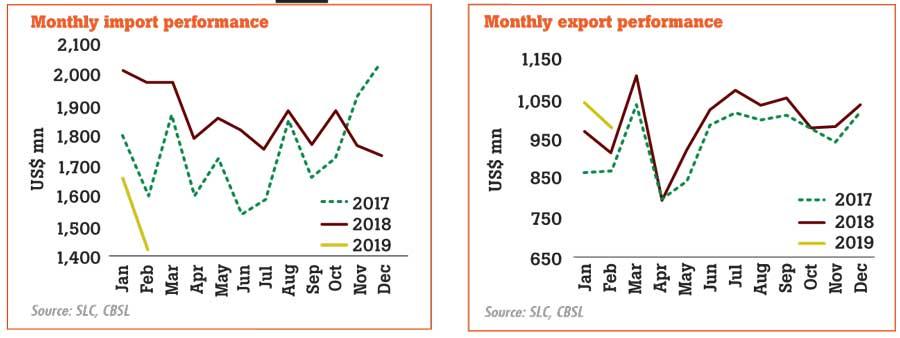Reply To:
Name - Reply Comment

Sri Lanka’s trade deficit significantly narrowed in February, largely owing to the slowdown in imports due to the measures taken by the Central Bank and government and increase in exports, the data released by the Central Bank showed, yesterday.
The February trade deficit narrowed to US $ 451 million, recording the lowest monthly trade deficit in more than five years, the Central Bank said.
The expenditure on merchandise imports in February fell 27.6 percent year-on-year (YoY) to US $ 1,432 million, reflecting the impact of policy measures implemented by the Central Bank and government to discourage the unnecessary consumption imports in the latter part of 2018.
The Central Bank said the February import figure marks the lowest value since May 2017.
The consumer goods imports in February fell 41.2 percent YoY to US $ 259.9 million, as both food and non-food imports fell significantly.
The expenditure on personal vehicle imports fell 57.7 percent YoY to US $ 48.1 million.
The intermediate imports in February also fell 24.2 percent YoY to US $ 831 million as fuel imports fell 10.6 percent YoY to US $ 281.8 million.
The textile and textile articles imports also fell 14.2 percent YoY to US $ 212.2 million.
The expenditure on gold imports continued to be stagnant in February 2019 as well, reflecting the impact of the imposition of customs duty on gold in April 2018.
The expenditure on investment goods fell 10.4 percent YoY to US $ 341 million over the lower building material and transport equipment imports.
Meanwhile, the earnings from merchandise exports in February rose 7.2 percent YoY to US $ 981.1 million on improved industrial exports and recovery in agricultural exports.
The textile and garment exports rose 14.4 percent YoY to US $ 465.6 million while the rubber products exports, which mainly consist of rubber tyres, edged up 2 percent YoY to US $ 69.7 million.
The gems, diamonds and jewellery exports rose 17.5 percent YoY to US $ 27.1 million.
The agricultural exports during February edged up 0.8 percent YoY to US $ 207.8 million amid the higher coconut and spice exports. However, tea exports fell 6.4 percent YoY US $ 110.6 million.
The Central Bank said the country’s gross official foreign reserves are estimated to have increased to US $ 7.6 billion by end-March 2019, following the receipt of the international sovereign bond (ISB) proceeds.
Sri Lanka raised US $ 2.4 billion through five-year and 10-year dollar-denominated bonds in
early March.
The Central Bank said the government repaid ISBs of US $ 1 billion that matured in January 2019 and US $ 500 million that matured in the second week of April, as scheduled.
The monetary authority also said the restoration of market confidence, staff-level deal with the International Monetary Fund and normalisation of the US Fed rates helped the rupee to appreciate 1.6 percent against the US dollar, by end-February.
“The exchange rate further appreciated thereafter, recording an appreciation of 4.8 percent up to April 22, 2019,” the Central Bank said.
The workers’ remittances declined by 12.4 percent YoY in February to US $ 500 million.